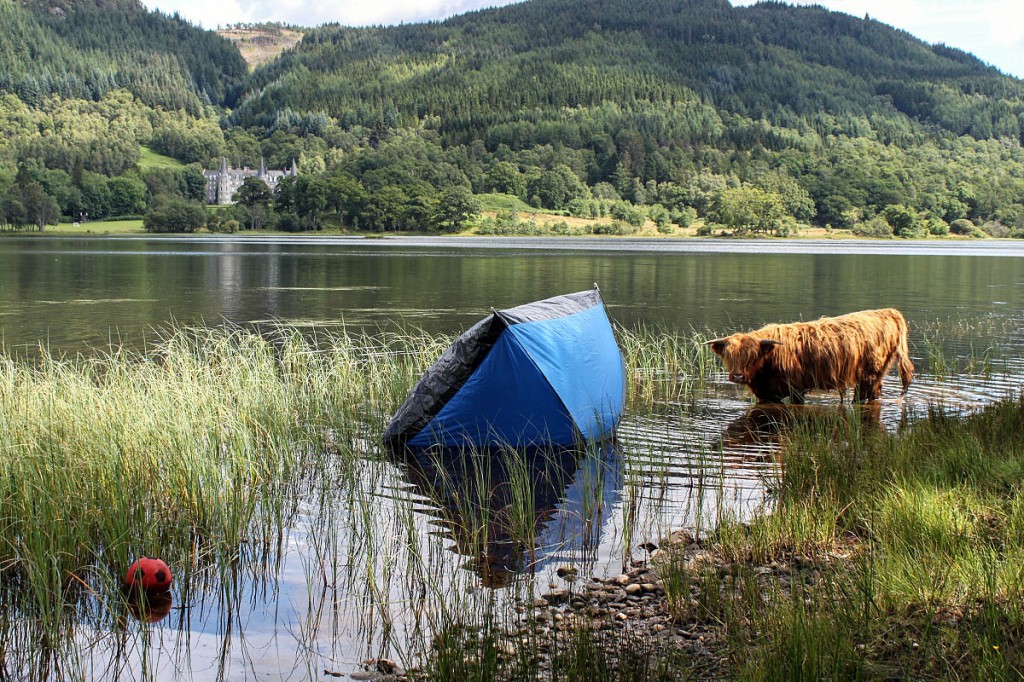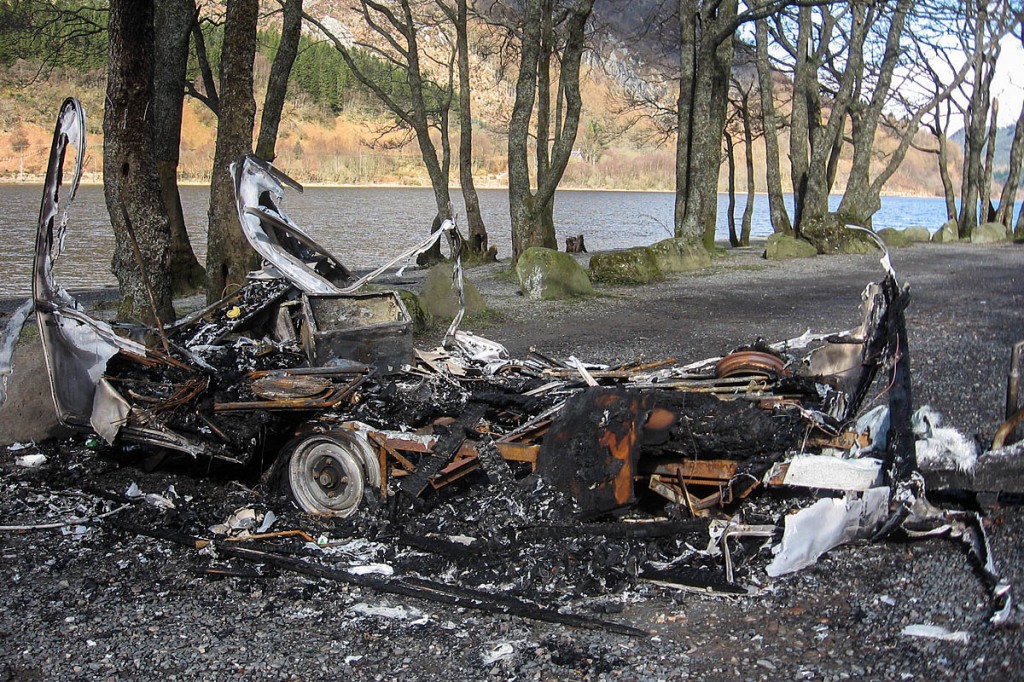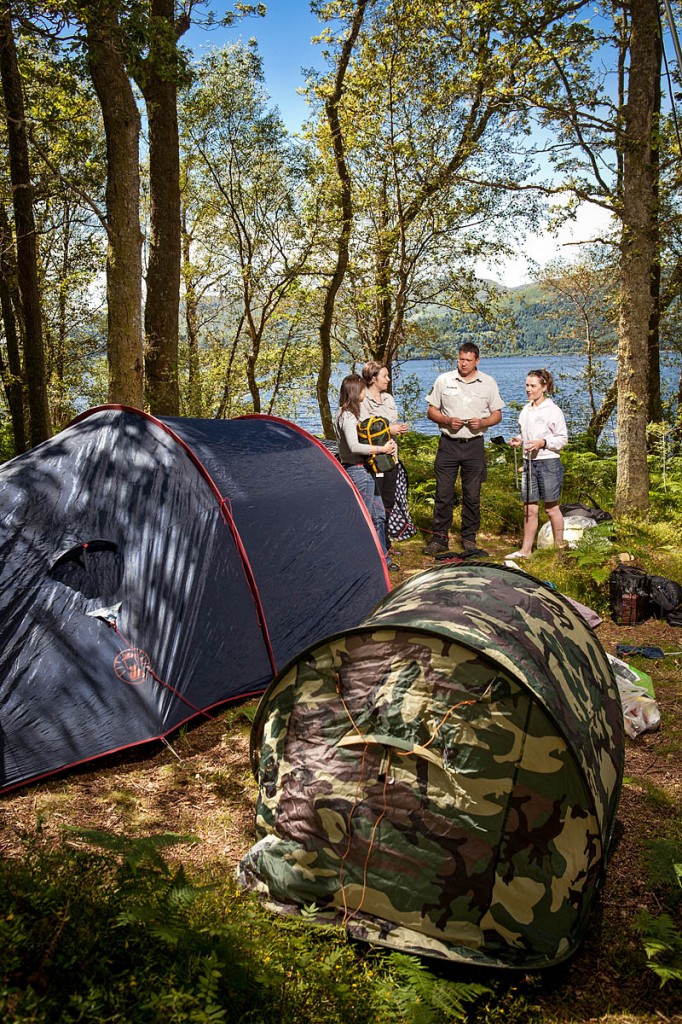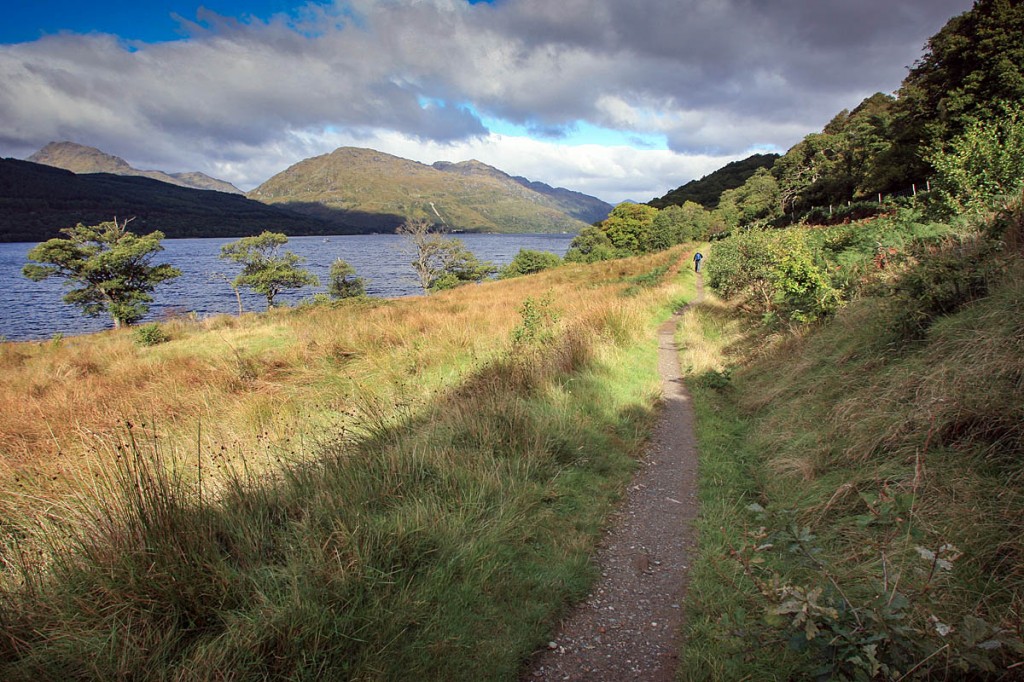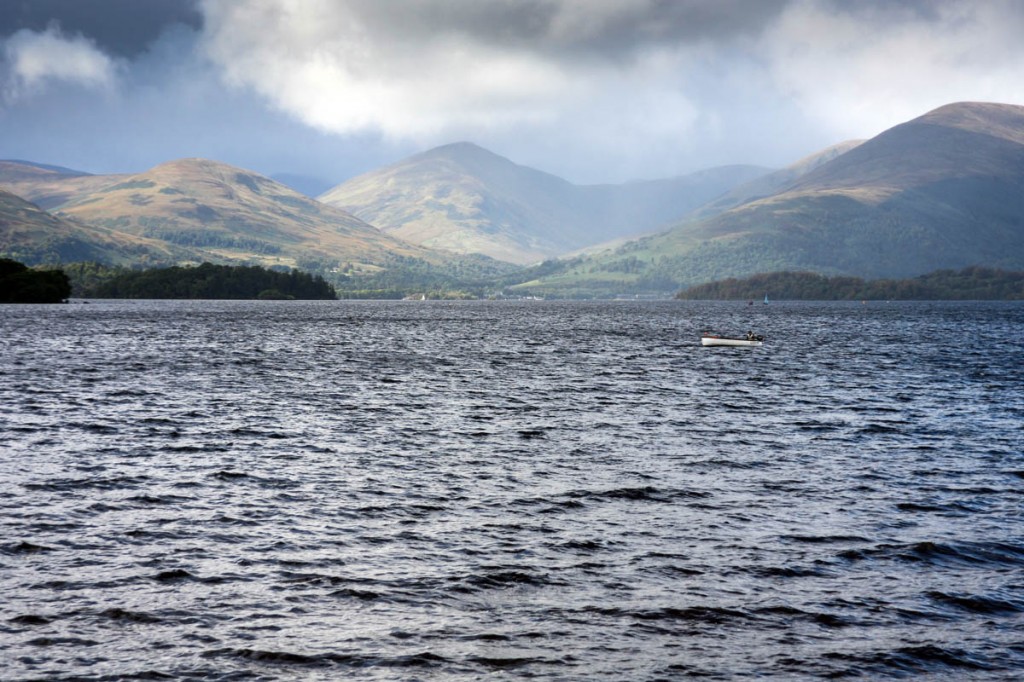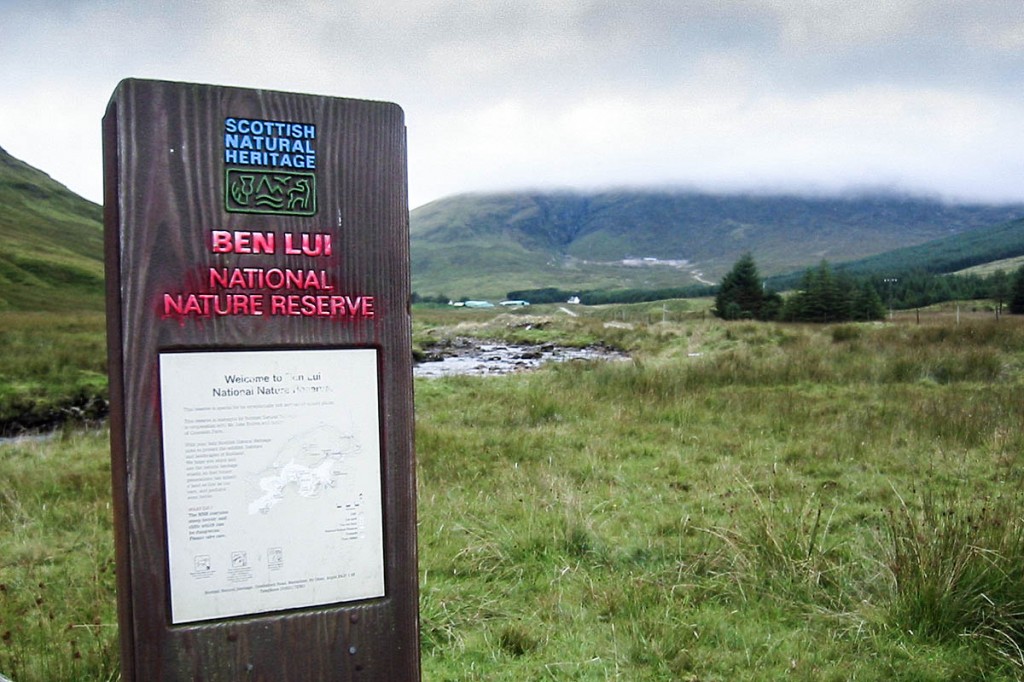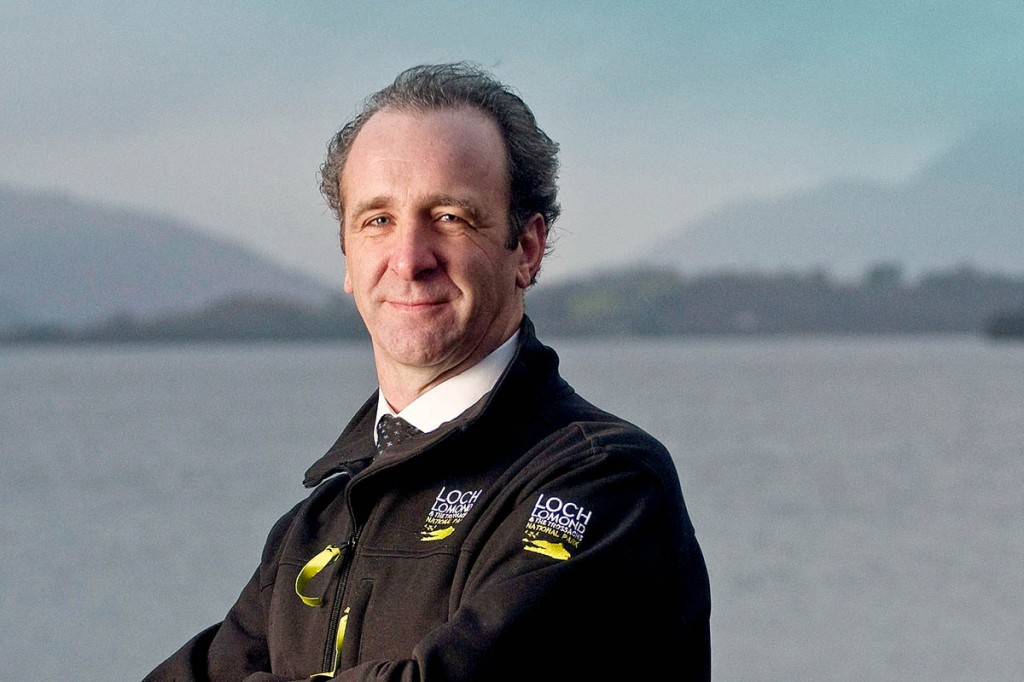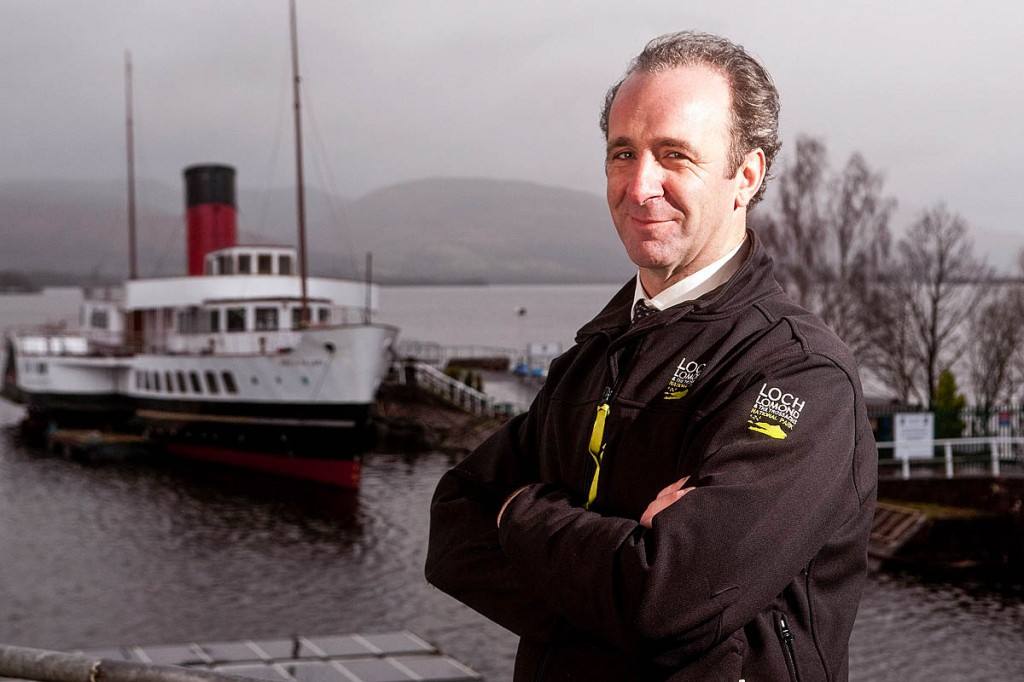
Gordon Watson, who has taken over as chief of the Loch Lomond and the Trossachs national park. Photo: Nick McGowan-Lowe
The man in the hot seat at Scotland’s first national park has told grough why he thinks the controversial proposals to ban camping on many of its loch shores are vital to conserve the environment of the park.
Gordon Watson has taken over as chief executive of the Loch Lomond and the Trossachs National Park Authority at a time when park bosses are embroiled in a war of words with outdoor campaigners.
The Glasgow-born chief is no stranger to the controversy. He was director of operations at the Balloch-based authority before stepping up to head the organisation. The proposals to ban wild camping along the lochsides of many popular areas in the park follow a similar scheme set up along the east shore of Loch Lomond in 2011 in response to anti-social behaviour, drunkenness and environmental damage by campers.
Both Ramblers Scotland and the Mountaineering Council of Scotland have opposed the proposals, saying they would undermine the right to wild camp enshrined in the Land Reform (Scotland) Act.
But the 48-year-old chief executive said the new restrictions would actually improve access for walkers who currently avoid the hotspot areas because they are not nice places to visit.
He said: “I think they [Ramblers Scotland and MCofS] are taking a narrow view of access rights in making those statements.
“What we have at the moment in these very focused hotspots on the lochsides is a situation where people who are not camping cannot and access them because in busy summers, it’s wall to wall camping.
“We can’t actually control that at all under the current situation and also these are pretty unpleasant and sometimes intimidating places to be. So the idea that this is wild camping under the definition in the Outdoor Access Code or that their members would dream of actually wanting to be in these places in some of the worst times is just not the case.
“What we are trying to do is to manage one particular recreational use – the volume of it – to allow access and allow other recreational activities to take place. So we are acting in the interests of the walker, the picnicker, the canoeist, who simply cannot access these places. We are taking a wider view of our responsibilities.
“The thing that is being totally overlooked in this situation is that the environment of these places is being totally degraded. A lot is being made of the anti-social-behaviour aspect, which is an issue, but the fact is the volume of camping, week-in, week-out, with human waste, sheer wear and tear on the habitats of these places, that the environment of the national park is being degraded.
“Until we can get a handle on managing the volume of camping that’s happening, there’s very little we can do about that so that’s what we want to do.
“We want to get facilities in place and we’ve done that in east Loch Lomond so that there are camping opportunities and they are as informal as possible, but in a way that’s making it a pleasant place to be for people to take recreation and access and to do that in a proportionate way.
“Until there’s a recognition of these issues by the Ramblers and mountaineering council, then it’s going to be difficult to reach a consensus, but we certainly want to do that.”
Mr Watson said the consultation that closed last month is just that, and the responses are being looked at. “At the moment, my team is analysing all 330-odd responses that we’ve had,” he said. Both the Ramblers and the MCofS have urged the Scottish Government to get involved to protect access rights. Mr Watson said: “I think it’s a bit premature suggesting government intervention when we’ve not actually been able to see what the consultation has said and decided what the next steps are.
“We will always be looking to communicate to everybody what has come out of the consultation and, just as we did in the lead-in to this, we’ll be meeting with a lot of the stakeholders to discuss what our thinking is next.
“In the lead-in to us preparing these proposals, we met with the Ramblers, we met with the mountaineering council, and the thing that has to be remembered is that there’s a much wider constituency involved here. We’ve met with all our partner organisations, communities in the park, businesses, conservation NGOs – they’re all stakeholders in this and they have views and expectations that we are trying to strike a balance between and we will continue to engage with them in the same way we did in the lead-in to this consultation.
“I completely refute the idea we’ve not been meeting people and not been listening and we will continue to do that as we move forward.
“We will be preparing a report that gives an overview of what’s been said in the consultation, the main issues that have come out from those comments. We will report the outcome of the consultation to the national park board and making recommendations as to what our next steps are with the proposals; what changes should be made to the proposals.
“Once we’ve done that, obviously we need to make decisions on investments in campsites, which is key to this, but the bylaw aspect of the proposal would have to go through to our minister at the Scottish Government and the minister would carry out a further consultation on that before deciding what to do in terms of approving or otherwise.
“So there are several steps to go and there is more consultation to come before any proposals actually get taken forward to implementation.”
It was pointed out that one of the authority’s officers, Grant Moir, had said in 2011 that there were no current plans to extend the camping ban to other areas of the Loch Lomond and the Trossachs national park, yet the authority was now proposing exactly that.
Mr Watson said: “The position was at that time that we wanted to look at how things worked on east Loch Lomond and I think Grant’s words were ‘we have no plans at that time’ but when we began implementing the package of east Loch Lomond measures, at that point we didn’t know what impact they would have.
“We’ve now completed our fourth season with the camping bylaw in place and all the other measures and the impact has been transformational.
“The area has been a fantastic place to be; a wider range of people are coming back to enjoy recreation in the area; it’s a fantastic advertisement for the West Highland Way now and communities and businesses are absolutely thriving.
“So we have now taken that experience and learnings to look at how we tackle the same problems at our other lochsides so I think we’ve been proportionate in making sure east Loch Lomond has worked. We’ve waited four seasons to establish that and now apply those learnings to the other lochsides where there are problems.
“It would be perverse not to take the things that are clearly working and look at how they might be applied to the other problem area.”
He said the authority had not received complaints about the camping ban from walkers on the West Highland Way, Scotland’s most popular long-distance route, 17km (10 miles) of which came under the new bylaw.
“We haven’t had complaints about the camping restrictions from anybody, really,” Mr Watson said. “Our rangers are on the ground, interacting with people, advising them. There are three campsites on east Loch Lomond. Sallochy is the one we developed as a really informal experience which is really the experience people are looking for and with the success in east Loch Lomond, we’re looking to expand camping opportunities that allow the activity to continue in a managed way.
“We did some visitor feedback in year three of the bylaws and that was overwhelmingly positive in terms of people’s experience of the area generally.
“That was interviewing visitors generally, whether it was West Highland Way walkers or other visitors to the area.
“At Sallochy, it’s £5 a night for an adult and £3 for a child. You have composting toilets, running water, and there’s a central camping area but there are really informal clearings along the route of the West Highland Way which means it’s very informal in the trees – as close as you can get to a wild-camping experience on that site.”
Gordon Watson can claim a detailed knowledge of the national park, as he has been involved since it was set up 12 years ago. He worked for planning authorities in the North of England early in his career including North Yorkshire and County Durham before coming back up to Scotland and working in Dunbartonshire. “Obviously, a part of the attraction of that was that it covered a big chunk of Loch Lomond and I’ve been working in the area since 1991,” he said.
“Working with West Dunbartonshire, I was in charge of planning policy and through that role I became involved in the working group looking at that time at both the management of the both Loch Lomond area which at that point was a regional park and the Trossachs, which didn’t have any designation.
“At that point, the Government policy was that there were to be no national parks in Scotland so what we were working towards was a joint working group committee to oversee the management of the area and as that developed devolution happened, and an early development from that was that Donald Dewar came to Balmaha to declare that the new devolved government policy was to take forward national parks in Scotland and one of the first bills under the Scottish Parliament was the National Parks Bill and that Loch Lomond ant the Trossachs would be the first designated.
“So the role moved towards the preparatory work to support the designation, where the boundary where was going to be, what powers the park would have and after that prepare for setting up the national park authority itself.
“During that time I was seconded from West Dunbartonshire to help the process. There was an interim organisation which I worked with and that involved members from the surrounding councils: Argyll, Stirling, Dumbarton, and a number of Government-nominated people. There was an interim period between 1999 and 2002 where I was seconded into that role. In 2002 when the park authority became established I applied to be a director and became its first director of planning.”
He said wryly: “It has been a quieter start to the new job than it was to the end of the old job.”
Unlike their counterparts in England which have seen their budgets slashed by 30 per cent by the coalition Government, the two Scottish national parks have fared better financially.
The annual budget for the Lomond authority is about £8m. Mr Watson said: “That is all grant in aid from the Scottish Government. About a million pounds of that is capital. We get no direct funding from local authorities. Our other income is on a project basis.
“We do a lot of partner projects where we do get income from partner organisations as part of a project we’re leading on, so our core budgets are 100 per cent Scottish Government.
“We’ve been very fortunate in Scotland. We’re a non-departmental public body which is a difference with the setup in England. That mean we’re answerable to our minister, the minister for environment, and as the spending reviews for the Scottish Government happen, we are obviously making the case for what we are delivering and how that fits with wider government agendas and we then receive our funding settlement as a result of Scottish Government spending reviewed decisions.
“Over the past three years we’ve been very fortunate that the cuts in our non-capital budget have been limited to two per cent per year, so six per cent over the past three years, including the coming year.
“But the thing we’ve managed to argue for and have been successful in is to increase our capital budget. Up until three years ago we had very little capital, but we have been successful in achieving a capital budget of over £1m per year over a three-year period. That’s been through demonstrating what we’re achieving with that money and the wider benefits for the park and beyond.
“Scottish Government support for its two national parks has been very strong and we’ve benefited from that.
“Central to our partnership plan is ensuring we’ve got the right standard of visitor facilities that meet visitor expectations but also cope with the number of visitors we have. We spend a significant amount of money on long-distance routes and path networks.
“We have the West Highland Way which requires a lot of investment. We’re investing in things such as pier infrastructure; we’re supporting waterbus services which are a key sustainable transport service for our visitors to get around Loch Lomond and some of the other lochs. And a number of our very busy visitor sites have required investment so the facilities are there, whether that’s toilets, meeting the needs of different users such as camping and I think before there was a national park, that infrastructure was of a very poor standard and we’ve been progressively making it of a standard that is required in a national park.
“We’re doing it for local visitors but obviously we get a lot of international visitors too. We don’t just invest in the physical asset. We also make sure other businesses are seeing the opportunity that arises from that. So if we’re investing in cycle route, we’ve got hire companies and other providers providing the services the visitors want so they can make the most of that public investment.”
Unlike some authorities south of the border, the Loch Lomond and the Trossachs National Park Authority has not reduced the number of people it employs, Mr Watson said.
“We’ve managed to maintain staffing levels and part of the reason we’ve been able to do that is we’ve been focused on where we can generate income where previously we weren’t achieving income.
“So that has meant looking at charging for things such as toilets and car parking which were previously free. So in the visitor season, getting income streams that mean we can maintain services is really important for things like our ranger service which is key in terms of delivering our visitor management objectives and also interacting with visitors from an educational point of view as well.
“Where it is starting to affect us is where we support a number of projects which aren’t capital projects, such as the support we give to community projects, where things are starting to struggle a bit because we’ve got less discretionary money around.”
Commenting on a recent grough story on the proposed camping ban, Alastair McIntosh said the plans would penalise those without cars. His youth group, from Govan, would be affected by the bylaws.
Mr McIntosh said: “It would start to erode our preciously won right to roam and to inhabit our own country. It would be a blow not for freedom and responsibility, but for privilege.
“Yes, there people who abuse that freedom, but that needs to be dealt with by raising a sense of pride in place and in the meantime, accepting the need for clean-ups from time to time.
“Be glad that people want to come out of Glasgow and camp around their loch. Help to awaken them to reverence for the bonny bonny banks.”
Gordon Watson said: “If we’re investing in these facilities, it means they are available to groups such as those. We’re not looking to stop any of that.
“I would stress that the bylaw measures are presented as a blanket, inflexible thing, but even in east Loch Lomond, we can grant exemptions to organised groups who come to areas that can support camping, so it’s not the inflexible thing it’s been made out to be.
“And what we’re talking about is less than five per cent of the park. With initiatives with the waterbuses, for instance, we’ve established the position that you can get a train from the centre of Glasgow, get off at Balloch, get on a waterbus and get to east Loch Lomond or other parts of west Loch Lomond and you can get around the park without a car and be able to access the area with your rucksack and have an itinerary without a car.
“We work very closely with a lot of youth organisations and groups to encourage them to use the park.”
The park’s chief executive is very keen to see more city and town dwellers visiting the area. “The thing I want to see is finding ways to encourage people from central Scotland’s urban areas who are currently not accessing the park, to make it easier for them to do that, to get more young people enjoying those facilities, whether it’s walking or camping or whatever,” he said.
“And obviously there’s a health agenda. We’re close by some of the unhealthiest parts of Scotland and we’re looking to work with neighbouring authorities and other health-providing partners to encourage people to get active and get outdoors and we can help provide the experience that can enable people to do that.
“Visitor infrastructure is still the key part but broadening the benefits of that and particularly with our proximity to central Scotland, the park is there for more people to use and benefit from.”
Another controversial decision by the national park authority was the go-ahead for the re-opening of the gold mine at Cononish, near Tyndrum, in the shadow of the munro Ben Lui. Although consent has been granted to its developers Scotgold, no mining has started.
Mr Watson said: “There has been no start to the development yet. What’s been happening in the two years since the consent is that Scotgold have been trying to raise capital necessary to get the mine going.
“Part of the cost is, obviously, we are looking for all the necessary financial safeguards to be in place before the mine can start, so we have all the financial resources available should anything go wrong or Scotgold as a company fails, that we have the resources to restore the site.
“Those are all legally binding things that Scotgold has to fund as well as the actual capital to get the mine going, so they have been focusing on that.
“We actually have a planning application just now on the gold mine looking at minor adjustments to the operating hours for the mine and certainly Scotgold is active in gearing up for the gold mine getting underway and their projection is that they hope to get the gold mine going later this year, possibly in the summer.
“Part of the package that allowed us to approve the application was that there are significant conservation works happening in the glen alongside that, which have to happen as part of the mining operation and includes native-woodland expansion and various other improvements. The part we’ve been very focused on as part of the acceptability is the restoration techniques. This is a temporary mine and that, once complete, there will be no mine workings discernible in the landscape; in fact the landscape will have been improved.”
The national park boss said it will continue to improve facilities for hillwalkers and outdoor enthusiasts. “We’ll be continuing to invest heavily in walking and cycling routes in the park,” he said.
“We’re about to embark on a £3m programme to upgrade a lot of our mountain paths. We’ve been successful in getting [Heritage Lottery Fund] money for that. So that’s going to get underway this year and we’re working with communities on a lot of long-distance links.
“We’ve just constructed a bridge in Glen Tarken on Loch Earn which is going to help us complete an east-west long-distance route from St Fillans going through Glen Dochart to Crianlarich.
“So there’s a lot of work continuing to improve access routes generally in the park.”
And he’s quite happy with the size of his empire. There are no plans to enlarge the park, as happened with its big neighbour the Cairngorms national park.
Mr Watson said: “We have 720 sq miles and that is perfectly big enough for the job we have to do.
“We have the Cowal and Argyll area of our park which is the quieter area, but the core challenges are in the busier areas surrounding Loch Lomond and some of the Trossachs lochs. Those busy areas remain our focus both in addressing the negatives of their popularity but also turning those into opportunities and making them great places to be.”
